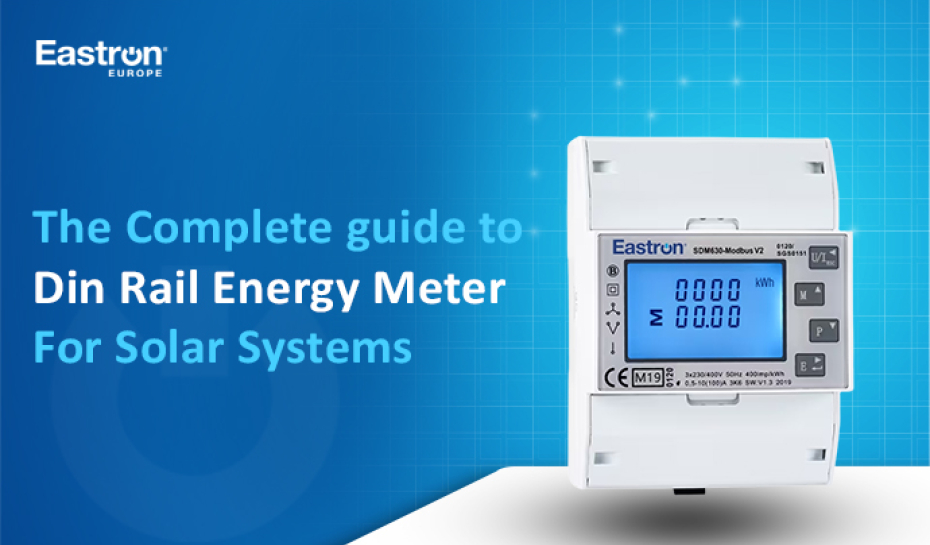
The Complete Guide to a Three-Phase Energy Meter for DIN Rail Solar Systems
As the solar energy sector continues to grow, the demand for accurate energy monitoring becomes increasingly critical. One essential component in any solar setup is the 3 phase DIN rail meter, a compact and efficient device for tracking electricity usage. While managing a commercial solar plant, select the right DIN rail-mounted electricity meter to optimise performance, ensure compliance, and reduce energy wastage.
How to Choose the Right DIN Rail Meter for Solar Applications
Choosing the right DIN rail meter for solar plant setups involves evaluating technical compatibility, functionality, and long-term value.
1. Determine Your Phase Requirement
Whether you are installing in a home or a utility-scale plant, phase compatibility is key.
- Single Phase: They are suitable for basic setups, homes, or small shops (e.g., Eastron Europe's SDM120 Series).
- Three Phase: They are essential for larger installations (e.g., Eastron Europe's SDM630 Series).
2. Check Metering Capabilities
Look for meters that measure more than just kWh.
- Multi-parameter Measurement: The metering devices must support the following measurement parameters: voltage, current, power factor, and frequency.
- Bi-directional Energy Flow: This is crucial for solar systems with feed-in tariffs or net metering.
- Tariff Control Support: The devices support time-of-use tracking for billing flexibility.
3. Connectivity and Integration Options
Modern solar systems often require remote monitoring and data logging. Some of the key features include:
- RS485 Modbus Support: This enables integration with SCADA or EMS systems.
- Pulse Outputs: It is essential for linking with external monitoring equipment.
- MID Certification: They ensure billing-grade accuracy.
Understanding Three-Phase DIN Rail Meters
In solar power systems, especially those catering to commercial, industrial, or utility-scale operations, three-phase energy monitoring plays a vital role. It is a precision instrument designed to measure electrical parameters across all three phases of power supply, offering a comprehensive view of energy consumption and generation.
Mounted on standard 35mm DIN rails within control panels or switchboards, these meters are valued for their compact design, easy installation, and robust accuracy. They are ideal for solar applications where reliability, remote monitoring, and billing-grade performance are non-negotiable.
What Makes Three-Phase Meters Different?
Unlike the single-phase version, which monitors just one line of voltage and current, three-phase DIN rail meters track all three live wires, providing data on phase balance, power factor, reactive energy, and more. This is essential for grid-tied solar plants, commercial complexes, and industries with high energy loads. For example, Eastron Europe's SDM630 Series is a high-end, Modbus-enabled, MID-certified meter, which is suitable for accurate billing and monitoring usage.
These are essential for medium to large-scale solar systems with a three-phase power supply.
Some of the primary benefits include:
- Full visibility of energy distribution across phases
- Accurate load balancing insights
- Multi-parameter tracking including kWh, kVARh, voltage, current, frequency, and power factor
How Three-Phase DIN Rail Energy Meter Benefits Solar Installations
Precise energy metering is the backbone of solar performance analysis, billing, and load management.
The key benefits of using a three-phase DIN rail meter for solar plants are:
- Optimising System Performance: Ensure your solar plant is producing and distributing energy as intended.
- Regulating Compliance: Meet grid code and utility billing standards with verified readings.
- Remote Monitoring and Alerts: Identify system failures or inefficiencies in real-time.
Key Installation Considerations for Three-Phase Meters in Solar Plants
1. DIN Rail Compatibility
- Ensure your distribution panel supports DIN rail mounting (standard 35mm wide).
2.Wiring and Safety
Follow manufacturer guidelines to avoid incorrect readings or hazards, such as:
- Use proper terminals and torque settings
- Install by a certified electrician
- Isolate power before wiring
3. Calibration and Maintenance
- Check if periodic recalibration is needed for billing compliance.
How to Future-Proof Your Solar Monitoring with Three-Phase DIN Rail Meters
With increasing demand for smart energy systems, it is essential to choose DIN rail meters that are scalable and interoperable.
Consider the following elements:
- Firmware upgrade capability
- Support for IoT platforms
- Expandability to three-phase from single-phase setups
Conclusion
Selecting the right metering device for your solar application isn’t just about measuring power; it is about ensuring long-term efficiency, regulatory compliance, and actionable insights. Eastron Europe’s three-phase DIN rail meters (SDM630 series) provide full-featured commercial solar setups along with reliable, certified, and scalable solutions.
